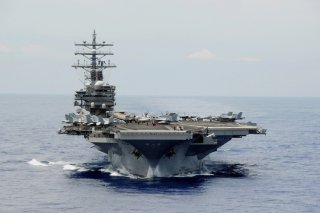This Is How to Save America's Aircraft Carriers from Becoming Obsolete
The aircraft carrier has long been a striking symbol of national power, but if it is not able to actually strike our enemies, then perhaps it is time for it to go the way of the battleships it replaced.
Senate Armed Services Committee chairman John McCain has released his annual “America’s Most Wasted” report on bloated defense programs and makes a startling suggestion: Cease building aircraft carriers. Such a move may well represent the most fiscally and operationally responsible path forward. The current Ford class carriers cost $12.9 billion each, and the Chinese have figured out a way to target them 900 miles at sea. But it would also ignore an investment that could extend the relevance of the carrier and America’s influence in the Pacific.
Each carrier today, with its accompanying compliment of sixty aircraft, can project power out to 500 miles and yet the current generation of carrier killing missiles being built by China can span out to 900 miles. The math involving range and cost of the weapons involved are decidedly not in America’s favor. However, this was not always the case. Supercarriers were designed in response to the losses from kamikaze attacks during World War II and they were built for a very specific purpose: To stand outside the range of enemy weapons and carry aircraft big enough to fly vast distances and drop a large load of bombs. Carriers and the aircraft that went on their decks were capable of striking deep inside the Soviet Union, and for forty five years the U.S. Navy was able to perform deep strike missions. However, following the end of the Cold War, the Navy began a rapid retreat from range. The service retired older aircraft such as the A-6 Intruder—which could fly 1,200 miles unrefueled—in favor of shorter range aircraft like the F/A-18 Hornet, which can only fly 500 miles.
This made sense for the permissive environments of the 1990s when no one contested U.S. military operations. American aircraft carriers positioned themselves just off enemy shores, overwhelming the locals with their awesome size while launching waves of aircraft throughout the day without fear of reprisal. However, the enemy gets a vote. Beginning in the 1990s, China began to invest in weapons designed to push carriers and their aircraft farther and farther away from their shores. The DF-21D anti-ship ballistic missile, which is designed to attack carriers as far out as 900 miles from its shoreline, threatens to remove the carrier from the list of relevant American weapons. America’s political leaders will be hesitant to risk a $12.9 billion asset carrying a crew of 5,000 sailors in an environment where they might be damaged or sunk. Such a loss would represent a military, diplomatic and political defeat for the United States, given the symbolic importance that has been attached to these icons of American power.
However, there is a solution. The Navy could invest in a strategy to bring a long-range, deep strike capability swiftly back to the carrier. Unmanned combat aerial vehicle designs now under consideration—aircraft that can fly 1,500 miles or more and drop a load of precision strike weapons on target—could keep the carrier in the game and relevant for the next generation of competition between nations. Adjusting the Department of Defense’s procurement strategy to allocate funds for the accelerated development of carrier based unmanned attack aircraft is the right move for the Navy and the nation. Otherwise the carrier becomes just another sunk investment with declining utility, which is a venture this country can ill afford.
Today, the conversation is very much about sailing a Naval vessel within twelve miles of a disputed artificial island. Tomorrow an American president may face a crisis that leaves him asking, “Where are the carriers?” But in the not too distant future, the challenge will be attacking a target 900 miles away. Some naval strategists have suggested that the way to deal tactically with new anti-access/area denial weapons is to pursue a sea-control wartime strategy. That would entail slowly eroding the enemy’s defensive perimeter over an extended period of time rather than investing in power projection—the capability to hit critical targets from range and thus shorten the war. Such an approach would ignore the lessons of history and needlessly raise the costs of war for the United States and the world economy.
John McCain is right to critically examine the rising costs and declining utility of the carrier. It is irresponsible to spend so much money on a platform so unsuited for the wartime strategic environment it is intended to operate in. If the Navy chooses not to pursue unmanned combat aerial vehicles in order to keep the carrier relevant in the future, then it is the time to move on to another generation of weapons. One option could be submarines carrying long range conventionally armed missiles and operating with impunity in the waters denied to the carrier. The aircraft carrier has long been a striking symbol of national power, but if it is not able to actually strike our enemies, then perhaps it is time for it to go the way of the battleships it replaced so long ago.
Jerry Hendrix is Director of the Defense Strategies and Assessments Program at the Center for a New American Security. He is a retired Navy Captain.

